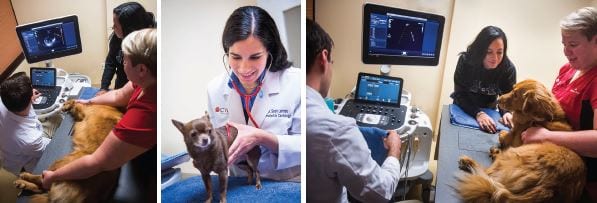What You Need to Learn About Vet Services: A Review of Diagnostic Equipments and Procedures
Vet services play an important duty in preserving the wellness of animals. Normal examinations can reveal concealed health problems at an early stage. Various analysis devices and procedures, such as blood examinations and imaging methods, supply necessary insights right into an animal's wellness. Recognizing these approaches is essential for pet dog owners. What details analysis treatments are most typically made use of, and how can they impact a family pet's therapy plan?
Value of Regular Vet Exams
While many family pet owners might ignore the relevance of normal veterinary exams, these visits are important for preserving a pet's total health. Regular brows through to the vet allow for early discovery of possible health concerns prior to they intensify right into serious problems. Regular exams frequently include vaccinations, which are essential for preventing infectious conditions that could seriously influence a pet's well-being. Additionally, these appointments offer a chance for veterinarians to evaluate the animal's weight, dental wellness, and total problem, ensuring that the animal is growing. During these check outs, animal proprietors can also receive valuable suggestions on diet regimen, exercise, and precautionary care tailored to their details family pet's demands.
Usual Diagnostic Procedures in Vet Medicine
In vet medication, exact diagnosis is essential for reliable therapy. Common analysis treatments include blood testing strategies, progressed imaging innovations, and urinalysis, each playing a considerable function in identifying wellness problems. Recognizing these techniques boosts the capacity to offer suitable look after animal clients.
Blood Testing Techniques
Blood testing strategies serve as vital diagnostic tools in vet medication, making it possible for veterinarians to evaluate the wellness of animals properly. These techniques include collecting blood examples to analyze numerous parts, such as white and red blood cells, platelets, and biochemical pens. Usual examinations include complete blood counts (CBC), which evaluate total health and wellness and spot infections, and biochemical panels, which analyze organ feature and metabolic standing. Furthermore, serological examinations can determine details conditions with antibody detection. Blood screening is minimally invasive and offers critical details that helps in diagnosing conditions, keeping track of health condition, and evaluating actions to therapies. Generally, these strategies play an essential duty in guaranteeing optimal care for animals and animals alike.
Imaging Technologies Made Use Of
Diagnostic imaging innovations are necessary tools in veterinary medicine, matching blood screening methods by offering visual insights into a pet's inner structures. Common imaging modalities include X-rays, which work for reviewing bone cracks and spotting foreign items, and ultrasound, which permits for real-time visualization of soft cells and body organs. Magnetic vibration imaging (MRI) uses in-depth photos of complicated anatomical areas, specifically in neurological evaluations. Computed tomography (CT) offers cross-sectional images, enhancing diagnostic accuracy for various conditions. Each of these technologies aids vets in identifying health problems, intending therapies, and monitoring recovery. By including imaging technologies, veterinary specialists can much better examine a pet's health and wellness and make informed decisions concerning their care.
Urinalysis and Diagnostics
Urinalysis acts as a vital diagnostic device in veterinary medication, providing beneficial understandings right into an animal's total health and wellness and assisting in the discovery of different conditions. This non-invasive treatment examines pee samples to assess kidney feature, hydration condition, and metabolic conditions. Common parts checked out include certain gravity, pH levels, sugar, proteins, and the visibility of blood or bacteria. Uncommon findings can show issues such as urinary system infections, diabetes mellitus, or kidney condition. To improve diagnostic accuracy, urinalysis is often executed together with other examinations, such as blood job and imaging studies. Early discovery with urinalysis can result in prompt interventions, boosting the prognosis for numerous vet patients. It is an essential facet of extensive vet treatment.
Understanding Blood Examinations and Laboratory Analysis
Understanding blood examinations and laboratory analysis is essential in veterinary medicine as it helps in detecting various health and wellness conditions in animals. Different types of blood tests give crucial information about an animal's interior state, while translating laboratory results calls for careful consideration of countless factors. This section will explore the kinds of blood examinations available and the importance of their outcomes.
Sorts Of Blood Tests
Blood examinations play a vital duty in veterinary medication, providing crucial insights right into a pet's health and wellness status. Different kinds of blood examinations are made use of, each offering various purposes. Total blood counts (CBC) evaluate general health and wellness and detect conditions such as anemia or infection. Biochemical accounts review body organ function by gauging enzymes and electrolytes, offering insights into metabolic health. Serological tests determine certain antibodies or pathogens, aiding in the diagnosis of infections or autoimmune illness. Blood keying warranties risk-free transfusions, while coagulation tests evaluate the blood's capability to clot, crucial for surgeries. These tests collectively improve medical diagnosis, therapy preparation, and monitoring of an animal's wellness, illustrating the importance of thorough lab analysis in veterinary care.

Translating Laboratory Outcomes
An extensive analysis of lab results is vital for exact medical diagnosis and therapy in vet medicine. Translating lab results needs an understanding of regular reference varieties and the relevance of discrepancies. Blood examinations can reveal different health signs, such as body organ function, electrolyte equilibrium, and the existence of infections. Veterinarians need to consider the entire clinical picture, consisting of the animal's history, physical exam findings, and any type of symptoms offered. Variants in results might emerge from elements such as age, breed, and underlying health and wellness problems. Lab outcomes need to redirected here not be watched in seclusion but rather as part of a comprehensive analysis strategy. Accurate analysis enables tailored therapy plans and much better outcomes for vet clients.
Imaging Techniques: X-rays, Ultrasounds, and Beyond
Imaging strategies are vital tools in veterinary medicine, giving essential insights into the health and wellness and well-being of animals. Among one of the most commonly used approaches are X-rays and ultrasounds. X-rays are very useful for visualizing bone structures, assisting veterinarians recognize fractures, growths, or foreign things. This method is quick and non-invasive, making it excellent for immediate situations.Ultrasounds, on the other hand, use audio waves to develop photos of soft cells and organs. This method is especially helpful for analyzing the heart, abdominal area, and reproductive organs, allowing vets to assess conditions like liquid accumulation or organ abnormalities.Beyond X-rays and ultrasounds, advanced imaging strategies such as computed tomography (CT) and magnetic resonance imaging (MRI) are significantly utilized in veterinary technique. These techniques provide comprehensive cross-sectional photos, boosting the accuracy of medical diagnoses and treatment plans. Cancer Veterinary Near Me. Overall, imaging techniques play a vital function in ensuring effective veterinary care
The Role of Biopsies in Diagnosing Pet Dog Wellness Issues
Accuracy in detecting wellness issues in pets commonly pivots on using biopsies, which provide clear-cut details about cells problems. A biopsy involves the removal of a tiny example of cells for evaluation under a microscopic lense, permitting veterinarians to identify numerous problems, consisting of infections, lumps, and inflammatory conditions. This analysis tool is crucial for comparing benign and malignant developments, assisting treatment choices, and examining the severity of a condition.Biopsies can be done making use of numerous strategies, such as needle desire, incisional biopsies, or excisional biopsies, relying on the place and kind of tissue involved. The option of method may influence recuperation time and the you can find out more amount of tissue accumulated. Ultimately, the info amassed from a biopsy can result in targeted treatments, improving outcomes for animals facing serious health obstacles. Vets highlight the importance of this procedure in achieving precise medical diagnoses and efficient therapy strategies.
Advanced Diagnostic Tools: Endoscopy and CT Scans

Advanced analysis devices, such as endoscopy and CT scans, play an important function in contemporary veterinary medicine, offering non-invasive techniques to picture inner frameworks and diagnose numerous conditions in animals. Endoscopy involves using a versatile tube furnished with a cam, allowing vets to check out the stomach system and respiratory system straight. This strategy can reveal irregularities such as lumps, foreign bodies, or inflammation, allowing targeted treatment plans.CT scans, on the other hand, make use of innovative imaging innovation to develop thorough cross-sectional photos of the body (Ultrasound For Dogs). This technique is specifically beneficial for evaluating facility frameworks like the mind, back, and joints. By giving high-resolution photos, CT scans aid vets in identifying concerns that may not appear through standard radiography. With each other, these innovative devices improve analysis accuracy, improve treatment end results, and inevitably add to far better general pet health management

Translating Test Outcomes: What Pet Dog Owners Ought To Know
Understanding test outcomes can be a difficult job for pet dog proprietors, particularly after innovative treatments like endoscopy and CT scans have been executed. Interpreting these outcomes requires an understanding of clinical terms and a clear understanding of what the searchings for show regarding the pet dog's wellness. Vets frequently offer explanations, but the complexity of the results can still cause confusion.Pet proprietors should proactively involve in conversations with their veterinarians, asking inquiries to clear up any type of unpredictabilities. It is essential to understand normal versus uncommon results and the ramifications for the family pet's treatment plan. Additionally, identifying that some results might call for more screening or monitoring can assist owners remain informed regarding their family pet's health journey. Eventually, a collective technique between family pet owners and veterinary professionals fosters far better wellness results and enhances the general treatment experience for pets.
Often Asked Inquiries
Exactly how Do I Choose the Right Veterinary Clinic for My Animal?
Selecting the right vet center involves investigating neighborhood choices, examining credentials, seeing facilities, and evaluating personnel interactions (Cancer Veterinary Near Me). Focusing on recommendations from trusted resources can help assure the very best care and atmosphere for a pet's health and wellness needs
What Should I Do if My Animal Declines to visit the Vet?
When an animal rejects to visit the veterinarian, it's recommended to remain calm, usage treats or playthings to tempt them, and consider scheduling a home see if anxiety continues. Perseverance and positive support are vital.
Are There Telehealth Options for Veterinary Providers?
Telehealth alternatives for vet solutions are significantly available, permitting family pet owners to talk to vets remotely. These solutions make it possible for discussions about health and wellness worries, advice on minor ailments, and follow-ups without requiring to go to a facility.
Just how Often Should My Family Pet Have Dental Examinations?
The regularity of oral exams for family pets normally depends on their age and type. Generally, vets suggest yearly oral examinations, although some animals might need even more constant brows through to maintain excellent dental wellness.

What Are the Prices Related To Veterinary Diagnostics?
The prices connected with vet diagnostics can differ extensively, usually varying from standard tests like blood job to innovative imaging strategies. Factors influencing costs consist of the facility's area, tools made use of, and particular examinations needed for each and every pet dog. Veterinary solutions play a crucial duty in keeping the wellness of pet dogs. While several pet owners may undervalue the relevance of normal veterinary exams, these consultations are important for preserving an animal's general health. In visit this site right here addition, these appointments provide an opportunity for veterinarians to analyze the pet's weight, oral health and wellness, and general problem, guaranteeing that the family pet is prospering. Precision in identifying health issues in pets often pivots on the usage of biopsies, which supply definitive information about cells irregularities. Furthermore, acknowledging that some results may call for more testing or monitoring can help owners remain informed concerning their pet dog's health journey.